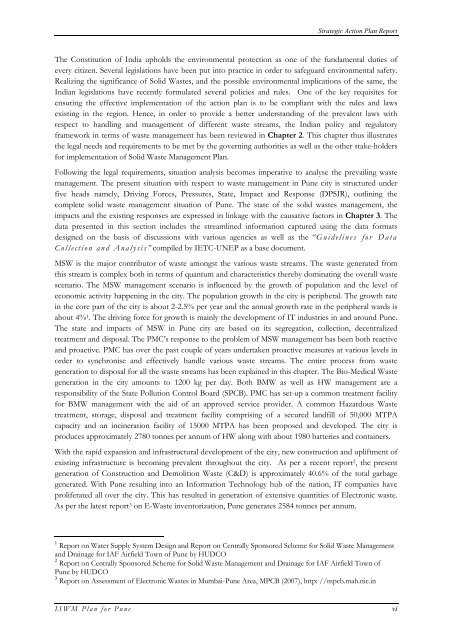Strategic Action Plan - International Environmental Technology Centre
Strategic Action Plan - International Environmental Technology Centre
Strategic Action Plan - International Environmental Technology Centre
You also want an ePaper? Increase the reach of your titles
YUMPU automatically turns print PDFs into web optimized ePapers that Google loves.
<strong>Strategic</strong> <strong>Action</strong> <strong>Plan</strong> Report<br />
The Constitution of India upholds the environmental protection as one of the fundamental duties of<br />
every citizen. Several legislations have been put into practice in order to safeguard environmental safety.<br />
Realizing the significance of Solid Wastes, and the possible environmental implications of the same, the<br />
Indian legislations have recently formulated several policies and rules. One of the key requisites for<br />
ensuring the effective implementation of the action plan is to be compliant with the rules and laws<br />
existing in the region. Hence, in order to provide a better understanding of the prevalent laws with<br />
respect to handling and management of different waste streams, the Indian policy and regulatory<br />
framework in terms of waste management has been reviewed in Chapter 2. This chapter thus illustrates<br />
the legal needs and requirements to be met by the governing authorities as well as the other stake-holders<br />
for implementation of Solid Waste Management <strong>Plan</strong>.<br />
Following the legal requirements, situation analysis becomes imperative to analyse the prevailing waste<br />
management. The present situation with respect to waste management in Pune city is structured under<br />
five heads namely, Driving Forces, Pressures, State, Impact and Response (DPSIR), outlining the<br />
complete solid waste management situation of Pune. The state of the solid wastes management, the<br />
impacts and the existing responses are expressed in linkage with the causative factors in Chapter 3. The<br />
data presented in this section includes the streamlined information captured using the data formats<br />
designed on the basis of discussions with various agencies as well as the “Guidelines for Data<br />
Collection and Analysis” compiled by IETC-UNEP as a base document.<br />
MSW is the major contributor of waste amongst the various waste streams. The waste generated from<br />
this stream is complex both in terms of quantum and characteristics thereby dominating the overall waste<br />
scenario. The MSW management scenario is influenced by the growth of population and the level of<br />
economic activity happening in the city. The population growth in the city is peripheral. The growth rate<br />
in the core part of the city is about 2-2.5% per year and the annual growth rate in the peripheral wards is<br />
about 4% 1 . The driving force for growth is mainly the development of IT industries in and around Pune.<br />
The state and impacts of MSW in Pune city are based on its segregation, collection, decentralized<br />
treatment and disposal. The PMC’s response to the problem of MSW management has been both reactive<br />
and proactive. PMC has over the past couple of years undertaken proactive measures at various levels in<br />
order to synchronise and effectively handle various waste streams. The entire process from waste<br />
generation to disposal for all the waste streams has been explained in this chapter. The Bio-Medical Waste<br />
generation in the city amounts to 1200 kg per day. Both BMW as well as HW management are a<br />
responsibility of the State Pollution Control Board (SPCB). PMC has set-up a common treatment facility<br />
for BMW management with the aid of an approved service provider. A common Hazardous Waste<br />
treatment, storage, disposal and treatment facility comprising of a secured landfill of 50,000 MTPA<br />
capacity and an incineration facility of 15000 MTPA has been proposed and developed. The city is<br />
produces approximately 2780 tonnes per annum of HW along with about 1980 batteries and containers.<br />
With the rapid expansion and infrastructural development of the city, new construction and upliftment of<br />
existing infrastructure is becoming prevalent throughout the city. As per a recent report 2 , the present<br />
generation of Construction and Demolition Waste (C&D) is approximately 40.6% of the total garbage<br />
generated. With Pune resulting into an Information <strong>Technology</strong> hub of the nation, IT companies have<br />
proliferated all over the city. This has resulted in generation of extensive quantities of Electronic waste.<br />
As per the latest report 3 on E-Waste inventorization, Pune generates 2584 tonnes per annum.<br />
1 Report on Water Supply System Design and Report on Centrally Sponsored Scheme for Solid Waste Management<br />
and Drainage for IAF Airfield Town of Pune by HUDCO<br />
2 Report on Centrally Sponsored Scheme for Solid Waste Management and Drainage for IAF Airfield Town of<br />
Pune by HUDCO<br />
3 Report on Assessment of Electronic Wastes in Mumbai-Pune Area, MPCB (2007), http: //mpcb.mah.nic.in<br />
ISWM <strong>Plan</strong> for Pune<br />
vi
















